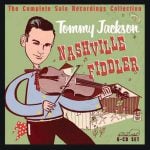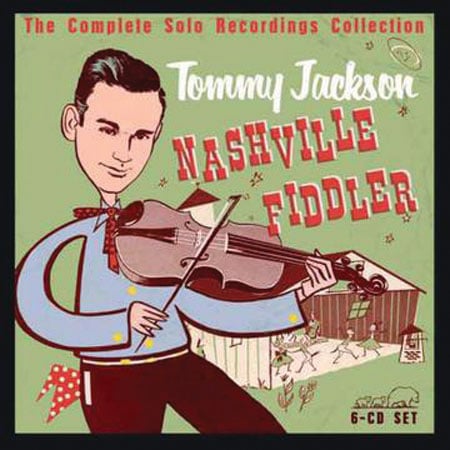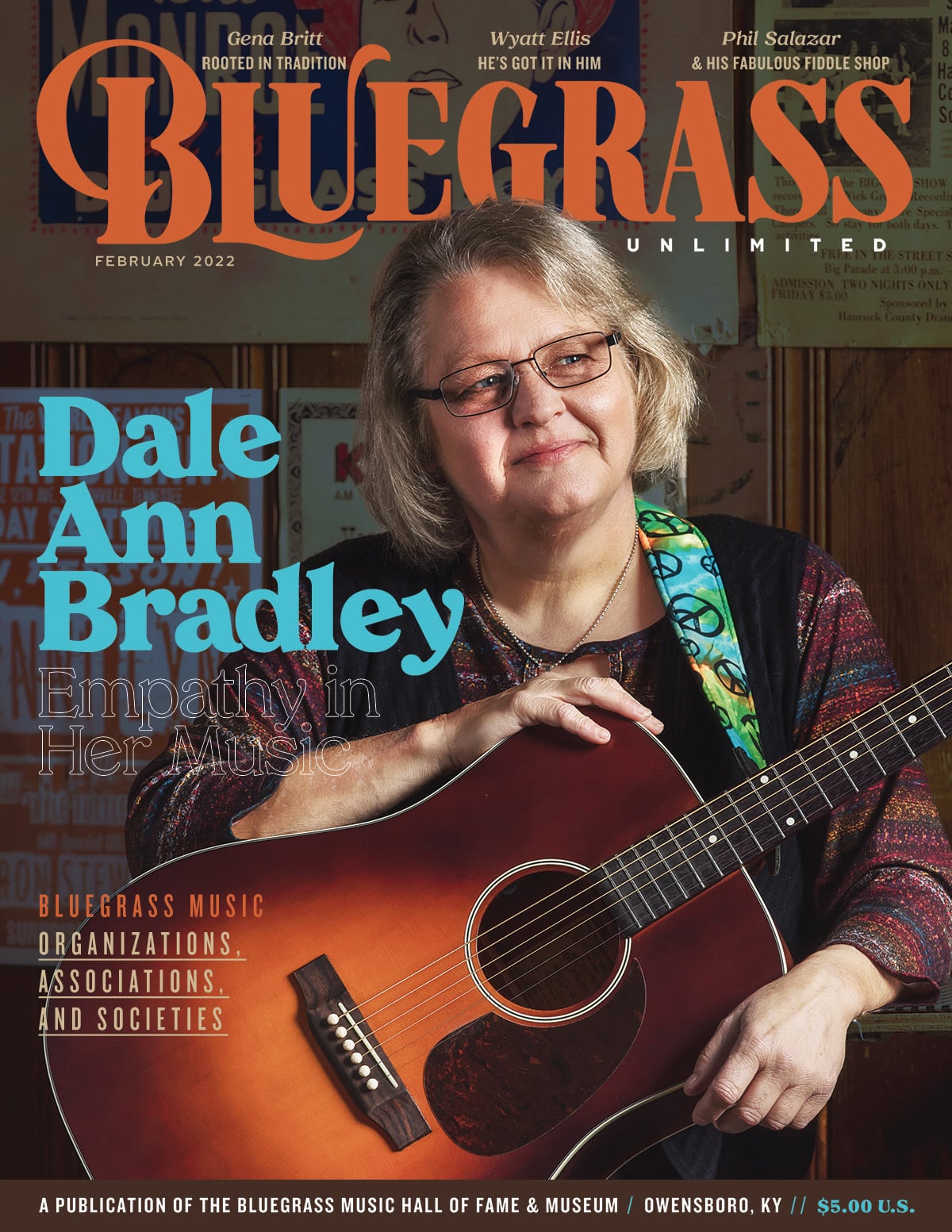TOMMY JACKSON
 TOMMY JACKSON
TOMMY JACKSON
NASHVILLE FIDDLER: THE COMPLETE SOLO RECORDINGS COLLECTION
and more bears AMB 71002
This is an amazing six-CD set that is astounding in its scope. Every one of Jackson’s solo recordings that feature his hoedown fiddling are here. Even if the CD cover says without calls, there are calls on some tracks. These are the hardcore square-dance recordings made for the craze that was sweeping the nation in the 1950s.
Tommy Jackson was an A-team fiddler in the Nashville music scene in the post-war period. If you’ve heard country music from that period through the late 1960s, you’ve heard Jackson fiddle. He played on a wide variety of sessions. There are many classic passages in country music that have one or more fiddles playing a classic phrase that made the song really pop. Jackson was most likely one of the fiddlers you heard.
Starrting with a session in 1949 when he recorded “Black Mountain Rag” and “Sally Goodin” (first recorded in 1922 by Eck Robertson), Jackson went on to record well over a hundred fiddle tunes. The ensuing recordings made him quite popular with fiddlers all over The States and across the world as his recordings were among the few that were readily available. His versions of fiddle tunes are textbook perfect. He doesn’t wow the listener with unnecessary pyrotechnics, but instead plays deceptively simple versions that get to the essence of the tune. His melodic awareness, timing, and bow control are epic. Cast in settings ranging from straight country to Swing and bluegrass, his fiddle comes through strong and clear, with concise precision.
For aficionados, there are some questions as to who played what instrument on some cuts. The booklet in the set features detailed background information, including excerpts from articles written in the early 1980s for these esteemed pages by the late Dr. Charles Wolfe, and a newer essay by Dr. Greg Reish. The discography lists the players on each session as far as it was documented, but questions still abound. For example, Haskel McCormick is listed as playing guitar, but it sure sounds like his banjo playing on the September 1959 sessions. There is a lot of great mandolin on this recording. Some is by Red Rector and Herschel Sizemore, but the note-for-note mandolin work with the fiddle is most likely Hank Garland. Garland was one of the greatest guitarists that ever lived and reportedly he held the mandolin in some disdain, but hey, a gig is a gig. You can see that the influence of these recordings was not just on fiddlers. Garland’s guitar playing displays licks that later Doc Watson used in his playing of fiddle tunes. The sliding double-stops and phrasing sure sound like what Watson was doing.
There is a little distortion on the earliest cuts. As the technology in the studios improved, the sound on these tracks became first-rate. The listener can track changes in country music by the tunes as they appear on this project. At first, there are classic evergreens, but over time, tunes from Fiddling Arthur Smith, Bill Monroe, and tunes that became contest classics start appearing. Some tunes were Jackson’s own creations, such as “Jackson Breakdown” and “Polk County Breakdown.” Hank Garland’s “Sugarfoot Rag” shows up, too. There are 178 cuts here in all. Many would go on to become fiddle standards and bluegrass favorites.
A real gem is nestled in this project—a whole album of Jake Landers and Rual Yarbrough and The Dixie Gentlemen. In that band for this session are Herschel Sizemore on mandolin and Tut Taylor on resonator guitar. No bass is listed, but one can be heard. They do a program of traditional songs and early bluegrass pieces that would become classics, including “Blue Moon Of Kentucky,” “In The Pines,” and “Cabin In The Hills.” Jackson’s fiddling is superb, but that should be no surprise.
Jackson’s repertory included pieces from such fiddle greats as Andrew Baxter, an African-American fiddler who recorded with the Georgia Yellowhammers, Métis-style fiddler Andy de Jarlis, and Red Taylor, a contemporary fiddler from Mississippi. This project also contains some fine twin-fiddling with Howdy Forrester. There are cuts that feature Jackson twinning the mandolin on breaks, including “Saint Anne’s Reel,” a tune from another Canadian fiddler, Bob Scott.
Until now, Jackson’s solo fiddle was only available on one CD from the British Archive Of Country Music, Tommy Jackson: The Legendary Session Fiddler (BACM 294). With twenty-some tracks, it’s a nice introduction. This set, however, is the real deal, comprehensively combining the wealth of fiddle-oriented material that this master fiddler recorded over a two-decade span. Red Rector’s old Gibson A mandolin dances through the tunes, as does Garland’s guitar and mandolin. For most bluegrass lovers, it should be enough to know that Sam Bush devoured these recordings as a youngster and, while most of this is not bluegrass, it is all great fiddling.
The sixth and final CD begins with some tunes recorded with calls and then includes covers of country hits on which Jackson’s fiddle is part of the ensemble, only stepping out to solo on one semi-hot jam, a recasting of “Columbus Stockade.” The remainder of the CD demonstrates Jackson’s true command of his instrument with ten well-known waltzes that drip with that sweet sound that only great fiddlers can bring.
It’s interesting that German and English labels keep our musical heritage alive with the help of some scholars here in The States. We are all richer for having access to these recordings that are bound to bring back memories for the older fans and at the same time provide an idea of what came before for the younger fans. (And More Bears, c/o P.O. Box 13413, Roanoke, VA 24033.)RCB

